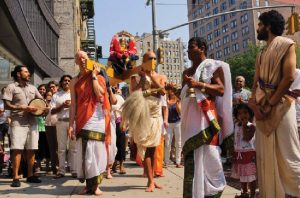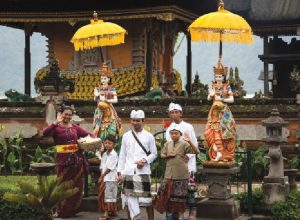 Western Religions & Cultures like Judaism, Christianity, & Islam tend to focus (though not exclusively) on the exoteric aspects of their religions, including social justice questions, as a precondition for World Peace. Various iconic symbols of Sanatan Hindu Philosophy, like the famed Male-Female voluptuous embrace, which in essence signify the balance of male and female principles or opposites as a symbol of the path to attain spiritual union with God, but had often been sadly misinterpreted by the Westerners. What it really signifies is that the spiritual, mystical path requires the balancing and transcending of opposites, not the elimination of opposites, as is propounded by other religious thoughts.
Western Religions & Cultures like Judaism, Christianity, & Islam tend to focus (though not exclusively) on the exoteric aspects of their religions, including social justice questions, as a precondition for World Peace. Various iconic symbols of Sanatan Hindu Philosophy, like the famed Male-Female voluptuous embrace, which in essence signify the balance of male and female principles or opposites as a symbol of the path to attain spiritual union with God, but had often been sadly misinterpreted by the Westerners. What it really signifies is that the spiritual, mystical path requires the balancing and transcending of opposites, not the elimination of opposites, as is propounded by other religious thoughts.
The Greek philosopher Pythagoras (c. 580–c. 500 BCE) is believed to have developed his doctrine of metempsychosis (transmigration, or passage of the soul from one body to another; see reincarnation) from India. The Pythagorean doctrine of a cyclic universe was possibly also be derived from India.
The most striking similarity between Greek and Indian thought is the resemblance between the system of mystical gnosis (esoteric knowledge) described in the Enneads of the Neoplatonic philosopher Plotinus (205–270) and that of the Yoga-sutra attributed to Maharshi Patanjali. Since the Patanjali text is the older, therefore, its influence is most probable.
Besides enamouring the Greek philosophy, the Hindu symbols and icons are discernible in countries like Nepal, Thailand, Indonesia, Cambodia, Vietnam and Japan in the East and Mauritius and Surinam, Guyana etc. in South America. In India what we refer to as Lord Yama, who is shown as riding a buffalo and is revered as the Chief Judge before whom everyone has to appear after death.
An identical icon, called Lord Emma-Ten is revered in Japan, where he is shown riding a buffalo and before whom everyone is supposed to appear after death. The qualitative attributes and the iconic appearance of Goddess Lakshmi familiar to us, has an identical counterpart in attributes and appearance in Japan, Goddess Kichijjo-Ten with Nyoihoju gem in her hand and standing on lotus flower.
Lord Ganesha or Lord Vinayaka (the Elephant Head God) is considered as the remover of obstacles and a god of good fortune. The Japanese have an identical elephant headed god called God Kangiten or Lord Binayaka-Ten with the same attributes.
While in India we have Lord Indra as the King of Heaven and Chief among Demi Gods who rides an elephant, the Japanese too have their Lord Taishaku-Ten as the King of Heaven and Chief of Demi Gods and riding an elephant. Indians worship Goddess Saraswati with musical instrument Veena in her hand as the Goddess of Learning, in Japan they revere Goddess Bezaiten with musical instrument Biwa in her hand for the same attributes. Here in India the famed seven centres of spiritual body in human body are called Chakras, while identical centres of spiritual energy in Japan are referred to as Chakuras.
Hinduism being the world’s third largest religion and widely professed in India, Nepal and Mauritius, is also the predominant religion in Bali (Indonesia). Indonesia, though officially a Muslim Nation, has Garuda Panchasilam as its National emblem. This emblem was designed by Sultan Hamid II from Pontianak, supervised by Sukarno, and was adopted as the national emblem on 11 February 1950. Garuda, the discipled carrier or vehicle (vahana) of Lord Vishnu, appears in many ancient Hindu temples of ancient Indonesia. In Indonesia the people of Bali still follow a form of Hinduism adapted to their own genius. As a matter of fact, the Indonesian National Air Carrier is also called Garuda Airways. Their 20,000 rupiah currency note has an inscription of Lord Ganesha, while the Indonesian military has Lord Hanuman as their mascot. In Indonesia the people of Bali still follow a form of Hinduism adapted to their own genius.
Hinduism in Vietnam is practised mainly by the ethnic Cham people, practice a form of Shaivite Brahmanism. Most of the Cham Hindus belong to the Nagavamshi Kshatriya caste, but a considerable minority are Brahmins. Cham Hindus believe that when they die, the sacred bull Nandi comes to take their soul to the holy land of India. Talking of Thailand which is a Budhhist majority nation, yet it has a very strong Hindu influence. The popular Thai epic Ramakien is based on the Ramayana.
 The Emblem of Thailand depicts Garuda, who is the vahana of Lord Vishnu. The Thai city, Ayutthaya near Bangkok, is named after Ayodhya, the birthplace of Rama. Numerous rituals derived from Brahmanism are preserved in rituals, such as the use of holy strings and pouring of water from conch shells. Outside shops, particularly in towns and rural areas, statues of Nang Kwak as the deity of wealth, fortune and prosperity (version of Lakshmi) are found.
The Emblem of Thailand depicts Garuda, who is the vahana of Lord Vishnu. The Thai city, Ayutthaya near Bangkok, is named after Ayodhya, the birthplace of Rama. Numerous rituals derived from Brahmanism are preserved in rituals, such as the use of holy strings and pouring of water from conch shells. Outside shops, particularly in towns and rural areas, statues of Nang Kwak as the deity of wealth, fortune and prosperity (version of Lakshmi) are found.
As early as the 5th century, Kulaprabhavati, a Cambodian queen, endowed a Vishnu temple in her realm. Enormous temples to Shiva and Vishnu were built in the ancient Khmer empire, attesting to the power and prestige of Hindu traditions in the region.
Angkor Wat, which is an iconic symbol of Cambodia, appearing on its national flag, and is the country’s prime attraction for visitors. It is a temple complex in Cambodia and is the largest religious monument in the world, on a site measuring 162.6 hectares (402 acres). Originally it was a Hindu temple dedicated to the God Vishnu, however, gradually it was transformed into a Buddhist temple towards the end of the 12th century.
Hinduism in South America is found in several countries, but is strongest in the Indo-Caribbean populations of Guyana and Suriname. There are about 550,000 Hindus in South America, chiefly the descendants of Indian indentured labourers in the Guyanas. There are about 270,000 Hindus in Guyana, 120,000 in Suriname, and some others in French Guiana.
In Guyana and Suriname, Hindus form the second-largest religion and in some regions and districts, Hindus forms the majority. In recent years the Sanatan influence has spread its reach far and wide mainly due to the efforts of Hindu Philosophy oriented organizations like the ISCKON and others, who conduct their bhakti sessions with lot of fervour and blissful exuberance. The Sanatan vibes are enamouring people globally.
Next issue: Maya-A chimerical reality or a phenomenal illusion in Hinduism
letters@tehelka.com













